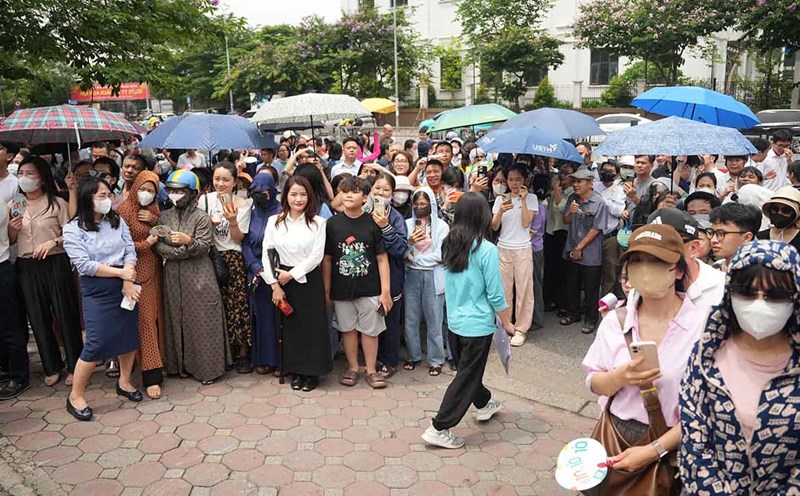Aiming to make Vietnam a high-quality medical destination, the Ministry of Health has implemented a project to develop high-quality medical examination and treatment services in the 2020-2030 period, aiming to build international treatment areas in most central and provincial hospitals, while developing medical tourism.
According to the project's targets, by 2030, the rate of central hospitals recognized as having high-quality international treatment areas will be 95%; the rate of provinces/cities with hospitals recognized as having high-quality international treatment areas will be 80% and the rate of foreigners receiving medical examination and treatment in Vietnam will grow by 1% or more annually.
mastering surgeries requires very high accuracy
And in recent times, the quality of medical examination and treatment at domestic medical facilities has developed significantly. In 2024, an Australian patient came to Vietnam for master cyst surgery using the single-hole endoscopy method - a technique that only two doctors in the world could perform at that time.
Associate Professor, Dr. Tran Ngoc Son - Deputy Director of Xanh Pon General Hospital (Hanoi) - was the one who directly performed this special surgery. According to Associate Professor Son, single-hole endoscopic surgery is a very difficult technique, requiring doctors to operate accurately in a narrow space, with all tools having to be taken through a small channel less than 2cm. The entire process of cutting off gallbladder bags, cutting the expanded gallbladder and reconnecting the gallbladder system is done through one hole, requiring experience and high accuracy.
Associate Professor Son has successfully performed more than 300 cases, with an infection complication rate of less than 1%.
On May 28, doctors from Tu Du Hospital and Children's Hospital 1 successfully intervened the fetal heart from the womb, suffering from aortic valve stenosis, mitral valve abnormalities - a form of rare congenital heart defects. The moment the ultrasound recorded the fetal blood flow back through the aortic valve right after the intervention, the couple burst into tears of emotion.
This is the case of the 9th fetal fetal heart intervention in Ho Chi Minh City, which is considered the most difficult shift because the fetus is still very young (25 weeks old, weighs 600g) and particularly severe medical condition.This case is also the first time Vietnamese doctors have done in foreign patients.
Dr. Do Nguyen Tin (Children's Hospital 1 Ho Chi Minh City) said that the first intervention on May 22 lasted many hours but failed because the fetal posture was unfavorable.To avoid risks, the crew decided to pause.Pregnant women stay in Ho Chi Minh City, persistently waiting for the desire to save the child to the end.Fortunately, at the second intervention, after more than two hours, the fetus turned in the right position, the doctors quickly performed a successful procedure.
This success not only affirms the professional capacity of the Vietnamese medical team but also opens up opportunities to develop fetal intervention techniques, bringing Vietnam closer to countries with advanced medicine in the region and the world.
To turn hospitals into star hotels
Associate Professor, Dr. Nguyen Lan Hieu - Director of Hanoi Medical University Hospital - said that medical tourism is a direction that many countries have implemented such as: Singapore, Thailand, Japan, Korea... Even the Philippines has 5-star hospitals to attract foreign visitors. Attracting foreign visitors to treat diseases is not a good way to promote the national brand. Combining medical tourism as an industry has proven to be as effective as in Singapore and Thailand.
Meanwhile, Japan and South Korea do not seem to focus on economic issues in this field, but it is clear that the national brand will reach new heights when heads of neighboring countries or billionaires fly to treat diseases. They are successful because in addition to turning hospitals into star hotels, professional quality is the top priority. New treatment techniques are always updated and implemented. Famous experts are attracted to create favorable conditions for professional development...
According to Associate Professor, Dr. Nguyen Lan Hieu, many of our hospitals have improved their services, so if we only need to build good processes, communication and support mechanisms, there will be not only one but many hospitals that are successful. With millions of overseas Vietnamese who need health care, treatment combined with hometown visits, our health system is responsible for thinking about this issue very seriously.
HCMC aims to become a leading health care center in the ASEAN region
Associate Professor, Dr. Tang Chi Thuong said that the important goal that the city is aiming for is to become a leading health care center in the ASEAN region. This not only contributes to retaining domestic people, limiting going abroad for medical examination and treatment, but also attracts international tourists to Ho Chi Minh City for high-quality health care.
Associate Professor, Dr. Tang Chi Thuong emphasized that the city's health sector is proud that many hospitals have been recognized by prestigious international organizations as meeting excellent professional standards in many fields such as: stroke, assisted reproduction, congenital heart surgery in children, treatment of heart failure... Some typical hospitals include People's Hospital 115, Tu Du Hospital, Hung Vuong Hospital, Children's Hospital 1, Gia Dinh People's Hospital...
In particular, for the first time in Vietnam, Ho Chi Minh City has public hospitals recognized as meeting international quality standards, such as the Hematology Blood Transfusion Hospital, which has been granted JCI (USA) certification and Hung Vuong Hospital, which has been granted ACHS (Australia) certification.
However, according to Associate Professor, Dr. Tang Chi Thuong, in addition to the achieved results, the health sector of Ho Chi Minh City still faces many challenges.
To break through, some key tasks that need to be implemented include: Upgrading grassroots health stations; building new degraded hospitals such as Mental Hospital, Orthopedic Trauma; narrowing the technical gap with countries with developed medicine; investing in high-tech disease screening centers and developing elderly care facilities, meeting the trend of population aging.











